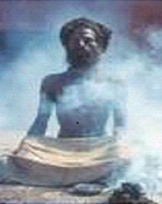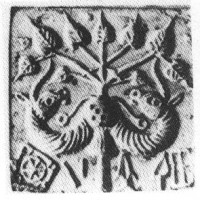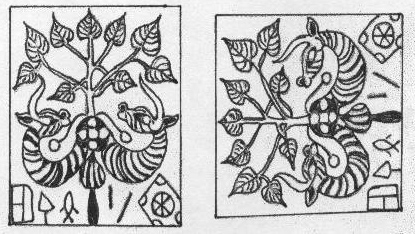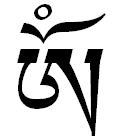Om or Aum is considered the primordial sound in the Sanatan culture. The modern representation of that sound (ॐ) is just the calligraphically shortened version of the proper Om alphabetically written in Devanagari script. On the surface, many Sanatan symbols like Om may seem to be ridiculous or even dumb, but discovering the deeper original ancient meaning and hidden creational processes behind those symbolisms is a sheer joy.

Sadhu Meditating in front of Fire
The roots of the Om symbol lie in the ancient practice of yogic meditation. Early humans in archaic times may have stumbled upon meditation shortly after they domesticated fire and began using it for warmth. Huddling close to the bonfires, they probably spent hours staring at the hypnotic flames. Even today Sadhus meditate in front of Dhunis (fire) as shown in the picture. At some point, our ancestors might have noticed that doing so could produce an altered state of consciousness similar to that produced by the use of certain plant extracts (like Soma plant of the Rigveda), sexual orgasm, physical trauma, and near-death experiences. They discovered that that state of mind also has a healing effect on the body and a calming effect on the mind. This realization lead them to discover ways to recreate that unusual state of mind at desired moment and place. Thus they discovered various meditation techniques. One of these techniques was to meditate with rhythmic utterance of the Om sound. This technique was named by our ancestors as Yoga (Yoga = to join – body and soul together).
More than seven thousand years ago in the Saraswati-sindhu valleys the Om sound was universalized by enlightened sages (Rishis). The Sanatan or Saraswatisindhu (Harappan) civilization flourished in those valleys. Seven thousand years ago the river Sindhu flowed similar course to its present course. The river Saraswati flowed for its lower course east of the Sindhu almost parallel to it and emptied into the gulf of Kachchh. Both the rivers originated in the Himalayas from glacier waters. It is believed that earlier than that time Saraswati flowed through the present day Nal Sarovar and emptied in gulf of Khambhat. The ancient port city of Lothal was situated on its bank.

5000 Year Old Om Sign from Ancient Sanatan Culture
The Sanatan culture which had its roots in these valleys was badly mauled and lost its forceful vitality due to loss of river Saraswati. It was due to plate tectonics and prolonged drought conditions. It did survive with less vigour and moved towards the outer areas and other river valleys like the Ganges, Naramda and Yamuna where it again flourished until pillaged by outside invaders. The original Om mantra not only has survived all these upheavals but also had spread all over Asia. In modern times it has moved almost all over the globe with the Yogic system of exercises and breath control.
The original representation (3000 BC) of the primordial Om sound in the Saraswatisindhu valley was as shown here complete with ancient writings. Quite a few of these ornately carved stone tablets have been excavated from several ruined cities like Dholavira, Rakhigrahi, Harappa, etc. The figure to the right represents a kind of flower pot (earth) nourishing a plant (life). Below is the same tablet shown in sketch form along with an sketch which has been rotated 90 degrees to show the resemblance clearly.

Sketch of Ancient Om Sign Rotated 90 Degrees
It will be obvious to any rational reader that it was the source from which the letter अ in the Devanagari alphabet was created. Many Devanagari alphabet letters were similarly created from sounds of familiar objects to the creators. In fact the original configuration shown in the left sketch is still used in Kannada language in Andhra Pradesh to express the Om sound.
The sound Om can be represented as ओम in Devanagari alphabet. The present form is made up of three letters, aa-अ, au-ओ and ma-म which, when combined together, make the sound Aum or Om (ओम). The subsequent gradual calligraphically changed representations are shown in the following figure along with the final sign used today in the Sanatan culture.

Sequence of Changes to the Om Representation in Devanagari
It is now clear to us that how the present symbolic representation of the ancient Om sound was metamorphosed by our forefathers.

Om Written in Tibetan Script
It might be interesting to note the representation of the sound Om in various Asian alphabets (Tibetan, Thai, Srilankan, Java, Taghalak, Khmer, Tamil, Telugu, Kannada, Malayalam, etc.). These were derived from the Brahmi script. The Brahmi script in turn was derived from the Saraswatisindhu syllabary which was used to carve words on the magnificent tablets (Seals) of our ancient culture. Om from the Tibetan alphabet is given here which confirms the point.
The story of the evolution of Om symbol to denote the primordial sound Om, presented here does not in any way diminishes its significance for the modern times. As a matter of fact it strengthens our faith in very ancient Sanatan culture as we now know the logic behind the ancient beliefs and symbolisms. The more we know the true meaning of these symbols and figures, more we may understand the true depth and hidden meanings behind our unique culture. Only through them our ancient faith has survived savage continuous onslaught from outside cultural forces and natural calamities.
Om is not a word but rather an intonation, which, like music, transcends the barriers of age, race, culture and even time. It is a mantra or prayer in itself. If repeated with the correct intonation, it can resonate throughout the body so that the sound penetrates to the centre of one’s being, the atman or the soul. There is harmony, peace and bliss in this simple but deeply philosophical sound recitation. It could only be experienced and cannot be described even with libraries full of written books.
The vibration produced by chanting Om in the physical universe corresponds to the original vibration that first arose at the time of creation of it (“The Big Bang” as per the modern astronomical theory). The sound Om is also called Pranava Nada, meaning that it sustains life and runs through Prana or breath. It is everything that was, is, or can yet be in the Universe. Om represents both the unmanifest (nirguna) and manifest (saguna) aspects of that Unknowable God.

